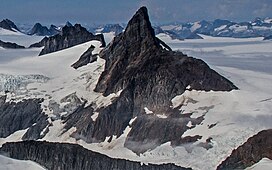| Rhino Peak | |
|---|---|
 Rhino Peak, south aspect Rhino Peak, south aspect | |
| Highest point | |
| Elevation | 6,400+ ft (1,950+ m) |
| Prominence | 1,000 ft (300 m) |
| Parent peak | Princess Peak |
| Isolation | 1.91 mi (3.07 km) |
| Coordinates | 58°33′32″N 134°26′21″W / 58.55889°N 134.43917°W / 58.55889; -134.43917 |
| Geography | |
 | |
| Location | Tongass National Forest Juneau Borough Alaska, United States |
| Parent range | Coast Mountains Boundary Ranges Juneau Icefield |
| Topo map | USGS Juneau C-2 |
| Climbing | |
| Easiest route | class 5.2 |
Rhino Peak is a 6,400+ ft (1,950+ m) mountain summit located in the Boundary Ranges of the Coast Mountains, in the U.S. state of Alaska. The peak is situated on the Juneau Icefield, 18 mi (29 km) north of Juneau, and 2 mi (3 km) west of Princess Peak, on land managed by Tongass National Forest. Rhino Peak is set at the head of Mendenhall Glacier. This peak's descriptive name was published in 1960 by the U.S. Geological Survey.
Climate
Based on the Köppen climate classification, Rhino Peak is located in a subarctic climate zone, with long, cold, snowy winters, and cool summers. Weather systems coming off the Gulf of Alaska are forced upwards by the Coast Mountains (orographic lift), causing heavy precipitation in the form of rainfall and snowfall. Temperatures can drop below −20 °C with wind chill factors below −30 °C. The month of July offers the most favorable weather to view or climb Rhino Peak.
Gallery
See also
References
- ^ "Rhino Peak, Alaska". Peakbagger.com. Retrieved 2020-03-27.
- "Rhino Peak". Bivouac.com. Retrieved 2020-03-28.
- "Rhino Peak - 6,450' Alaska". listsofjohn.com. Retrieved 2020-03-28.
- ^ "Rhino Peak". Geographic Names Information System. United States Geological Survey, United States Department of the Interior. Retrieved 2020-03-28.
- Peel, M. C.; Finlayson, B. L.; McMahon, T. A. (2007). "Updated world map of the Köppen−Geiger climate classification". Hydrol. Earth Syst. Sci. 11. ISSN 1027-5606.
External links
- Rhino Peak weather forecast
- Photo of Rhino Peak in lower right corner
- Rhino Peak Flickr photo
| Boundary Ranges | |
|---|---|
| Ranges | |
| Mountains | |
| Passes | |
| Icefields | |
| Parks | |
